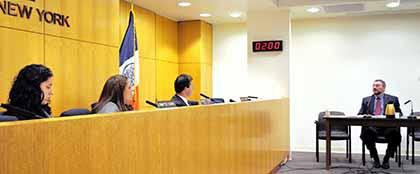By Joe Anuta
The fight to end hunger left city officials sparring last week over a controversial requirement for residents in Queens and other boroughs who need food stamps.
At a hearing last week at City Hall City Council members questioned the merits of finger imaging, the process of storing residents’ fingerprints into a large database designed to combat fraud in the food stamp program.
The fingerprints, once stored, can be cross-checked to avoid duplicate cases, when two food stamp allowances are given to the same person.
This year, the process caught 1,200 duplicate cases, which saved $3 million in federal money in 2010, according to Robert Doar, commissioner of the city Human Resources Administration and the Department of Social Services. The process also saved time since the finger imaging work is outsourced to another company. Doar said the department was able to handle an 11 percent increase in cases without adding any new staff members.
“The fact that our program has responded to the increased need for SNAP [Supplemental Nutrition Assistance Program] benefits … by significantly increasing enrollment without adding staff is an achievement that deserves recognition,” he said during the Council’s General Welfare Committee hearing on hunger.
Each year, the city spends $180,000 on the program — just 6 percent of the total savings for 2010.
But critics such as Joel Berg, executive director of the New York Coalition Against Hunger, said the process deters prospective food stamp users from applying since it must be completed in person, and many residents associate fingerprinting with criminal activities.
“You have to go to a city office,” he said. “It’s demeaning and time-consuming.”
Also, New York City is the only district in the state that requires finger imaging.
“Every other county in New York eliminated fingerprinting without an increase in fraud,” he said.
The 46 states that do not use finger imaging have more effective programs, according to Berg.
“They have higher percentages of participation and lower instances of fraud,” he said.
Currently, the city estimates that 60 percent to 70 percent of eligible residents take advantage of SNAP. But, according to Berg, it could be higher.
The department defended the practice.
The large number of people using the SNAP program requires a reliable system to check for fraud, a spokeswoman from the department said via e-mail.
She added that finger imagining does not deter people from signing up since growth in New York City alone was greater than in 31 other states and the four states that use finger imaging have some of the highest caseloads, yet all were in the top 25 growth rates from 2008 to 2009.Councilman Brad Lander (D-Brooklyn) disagreed and took issue with the $3 million since city money was used to pay for the program but only federal dollars were saved.
He said in a later telephone interview that the department could use other ways, such as cross-checking computer files.
“We believe they could catch these cases if they would use other techniques,” he said. The Council along with an official from the U.S. Department of Agriculture have called on the state to stop finger imaging, Lander added.
“Kevin Concannon wrote a letter to New York state, calling it a barrier to participation and saying it’s not cost-effective,” he said.
But aside from drafting a resolution stating its disapproval, the Council cannot legally stop the process. Only a statewide bill or a decision from the mayor would bring any change to the way SNAP is distributed.
Reach reporter Joe Anuta by e-mail at januta@cnglocal.com or by phone at 718-260-4566.
































